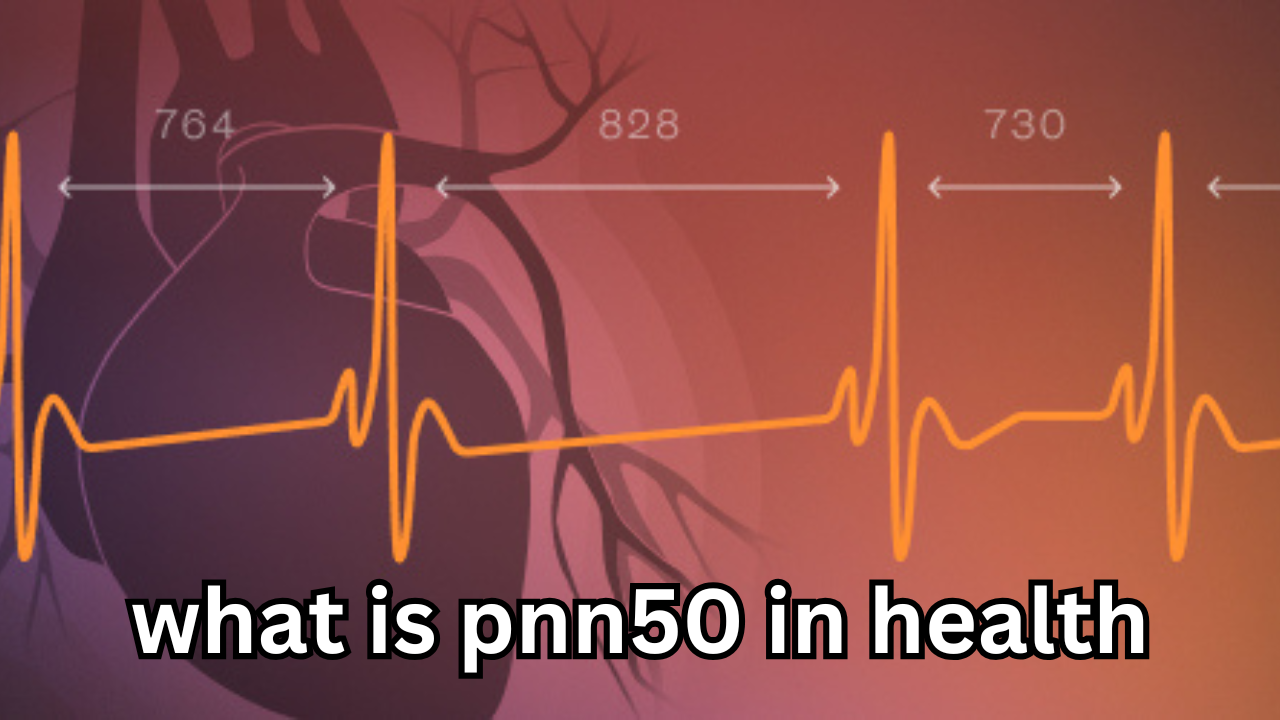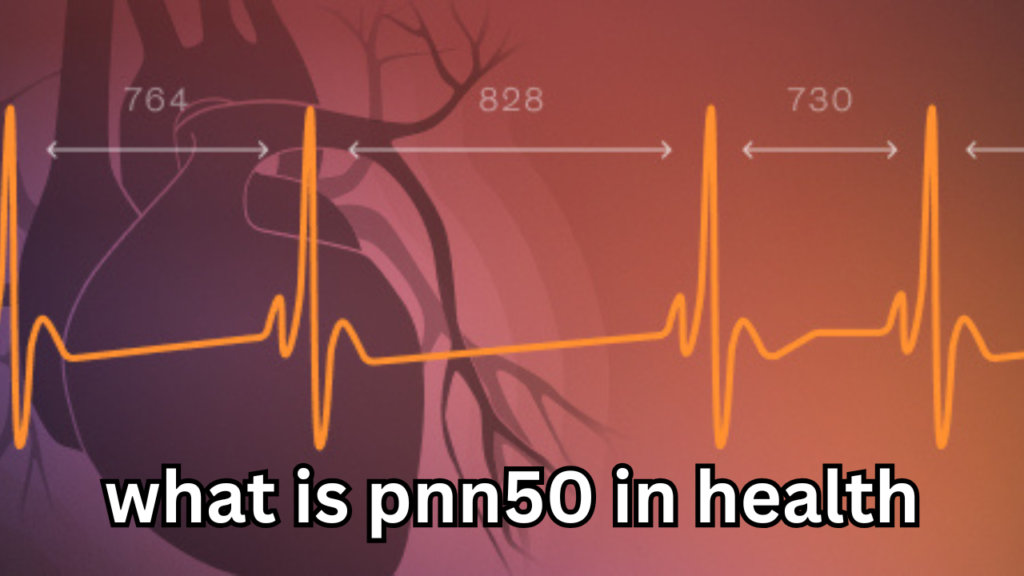

Table of Contents
Introduction:
Heart rate variability (HRV) is a vital measure of the autonomic nervous system’s function, reflecting the body’s ability to adapt to stress, recover, and maintain overall health. It is determined by the variation in time intervals between consecutive heartbeats, known as inter-beat intervals. High HRV typically indicates good cardiovascular health, resilience to stress, and effective recovery, while low HRV can be a sign of poor health and increased risk of cardiovascular issues.
One important metric in HRV analysis is pNN50, which stands for the percentage of pairs of successive RR intervals (the time between two heartbeats) that differ by more than 50 milliseconds. What is pNN50 in health? It is a key indicator of parasympathetic nervous system activity, which governs the body’s rest-and-digest functions. A higher pNN50 is generally associated with better health, lower stress levels, and a greater ability to recover. Understanding pNN50 provides valuable insight into the body’s stress response and its ability to maintain balance in everyday life.
What is pNN50?
pNN50 is a specific measure of heart rate variability (HRV) that represents the percentage of successive heartbeats (RR intervals) where the difference between them exceeds 50 milliseconds. In simpler terms, pNN50 quantifies how often there is a significant change in the time intervals between heartbeats, which is a reflection of the body’s autonomic nervous system (ANS) regulation. The ANS controls vital functions such as heart rate, digestion, and respiration, and it is divided into two branches: the sympathetic nervous system (responsible for the fight-or-flight response) and the parasympathetic nervous system (responsible for rest and recovery).
pNN50 meaning lies in its ability to specifically assess the parasympathetic nervous system’s activity. When pNN50 values are higher, it indicates stronger parasympathetic dominance, meaning the body is in a state of relaxation and recovery. On the other hand, lower pNN50 values suggest that the sympathetic system may be more active, potentially due to stress or an imbalance in the nervous system. This makes pNN50 an essential tool in assessing heart health and understanding how the body responds to various physiological and emotional stressors. By analyzing pNN50, healthcare providers can gain valuable insights into a person’s overall cardiovascular and autonomic nervous system function.
pNN50 Values and Their Significance
Normal pNN50 Values
pNN50 values can vary based on factors like age, fitness level, and overall health. For a typical, healthy individual, pNN50 normal values usually range between 15% and 30%, though this can fluctuate depending on individual circumstances. In general, individuals with higher levels of physical fitness tend to have higher pNN50 values, as regular exercise supports parasympathetic nervous system activity and improves heart rate variability. Conversely, RMSSD normal range, another HRV measure closely related to pNN50, typically falls between 30 to 60 milliseconds in healthy individuals, signifying balanced autonomic nervous system function.
Factors such as age can also influence pNN50 values, with older adults generally showing lower values due to decreased parasympathetic activity. It’s important to note that pNN50 values can vary considerably from person to person, but maintaining higher values is typically indicative of better overall health and a well-functioning autonomic nervous system.
pNN50 High Meaning
When pNN50 high meaning is discussed, it refers to a higher percentage of successive RR intervals differing by more than 50 milliseconds. High pNN50 values typically suggest strong parasympathetic nervous system activity, which is associated with better relaxation, recovery, and overall cardiovascular health. A high pNN50 value can also indicate that the body is managing stress effectively and maintaining balance between the sympathetic and parasympathetic systems. In this context, high pNN50 values are considered a positive health marker, reflecting the body’s resilience and ability to adapt to stress, recover from exertion, and maintain homeostasis.
pNN50 Low Meaning
On the other hand, pNN50 low meaning is a cause for concern. Low pNN50 values indicate reduced parasympathetic activity, suggesting that the body is not effectively recovering from stress and may be in a heightened state of arousal due to sympathetic dominance. This imbalance could result from various factors, such as chronic stress, anxiety, or cardiovascular problems. In many cases, low pNN50 values are associated with pNN50 overstressed conditions, where the body is constantly in a state of fight-or-flight response, hindering the ability to rest and heal.
Low pNN50 values are linked to a range of potential health risks, including increased susceptibility to heart disease, hypertension, and poor stress management. Conditions such as depression, anxiety, and other chronic stress-related disorders can also manifest with lower pNN50 values, as the autonomic nervous system struggles to restore balance.
pNN50 and Stress Levels
pNN50 is a key indicator of how the autonomic nervous system (ANS) manages stress. The ANS controls vital functions such as heart rate, digestion, and respiratory rate, and it operates through two primary branches: the sympathetic nervous system (SNS) and the parasympathetic nervous system (PNS). When the body is under stress, the SNS is activated, triggering the “fight-or-flight” response. This reduces the variability between heartbeats and suppresses parasympathetic activity, leading to lower pNN50 values. Conversely, when the body is relaxed or in recovery, the PNS takes over, increasing heart rate variability and raising pNN50 values.
pNN50 Overstressed
When someone is pNN50 overstressed, their pNN50 values tend to be lower due to an imbalance in the autonomic nervous system. Chronic stress, anxiety, or fatigue can result in prolonged sympathetic dominance, meaning the body remains in a heightened state of alertness, reducing the parasympathetic influence that facilitates rest and recovery. This overstressed condition leads to less variability between heartbeats and a diminished pNN50. Low pNN50 values, often associated with pNN50 overstressed, can indicate that the body is struggling to recover, which may contribute to long-term health problems such as cardiovascular disease, high blood pressure, and weakened immune function.
Is a High pNN50 Bad?
A common misconception is that is a high pNN50 bad when, in fact, high pNN50 values are typically a positive sign of health. Elevated pNN50 values are often associated with better cardiovascular health, improved stress management, and stronger parasympathetic activity. A high pNN50 indicates that the body is effectively recovering from stress, allowing for greater relaxation and better overall functioning. It suggests a well-balanced autonomic nervous system, where the parasympathetic branch is supporting rest and recovery after periods of stress. Therefore, high pNN50 values are generally beneficial and indicate good health.
Improving pNN50 and HRV
Improving pNN50 and overall heart rate variability (HRV) is essential for enhancing cardiovascular health, managing stress, and promoting a balanced autonomic nervous system. Fortunately, there are several lifestyle changes and techniques that can help improve these metrics, leading to better overall well-being.
How to Improve pNN50
To understand pNN50 how to improve, it’s important to focus on practices that promote parasympathetic nervous system activation. Regular physical activity is one of the most effective ways to boost HRV and pNN50. Exercise, particularly aerobic activities such as walking, running, or cycling, strengthens the heart and enhances the body’s ability to recover from stress. Staying active also improves blood circulation, reduces inflammation, and boosts overall cardiovascular health, all of which contribute to better HRV and pNN50 values.
Adequate sleep is another critical factor in improving pNN50. Consistent, restful sleep allows the body to recover, repair, and maintain healthy autonomic function. Poor sleep or sleep deprivation disrupts the balance between the sympathetic and parasympathetic systems, leading to lower HRV and pNN50. Aim for 7-9 hours of quality sleep each night to maximize recovery and improve pNN50.
Managing stress is equally important in improving pNN50. Chronic stress, both physical and emotional, can keep the sympathetic nervous system in a state of overdrive, suppressing parasympathetic activity and lowering HRV. Learning how to manage stress effectively can significantly enhance pNN50 and overall heart health.
Techniques for Enhancing HRV
There are specific techniques for boosting HRV and improving pNN50. Breathing exercises are one of the most effective ways to stimulate the parasympathetic nervous system and improve HRV. Slow, deep breathing, especially techniques such as diaphragmatic breathing and paced breathing, can increase the time between heartbeats and enhance pNN50 values. A common breathing practice to try is inhaling for a count of four, holding for four, and exhaling for a count of four, repeating the cycle for several minutes.
Meditation and mindfulness practices also have a profound impact on HRV and pNN50. Meditation helps reduce stress, increase relaxation, and activate the parasympathetic nervous system. Mindfulness practices, such as guided imagery or body scans, can help reduce emotional and mental stress, leading to improved heart rate variability over time.
Other techniques that support HRV improvement include yoga and Tai Chi, both of which combine physical movement with breath control and relaxation. These practices can significantly enhance parasympathetic activity and contribute to improved pNN50 values.
pNN50 in Different Populations
pNN50 is an important marker of heart rate variability (HRV) that reflects autonomic nervous system function and overall cardiovascular health. However, pNN50 values can vary significantly among different populations, such as athletes, the elderly, and individuals with certain medical conditions. Understanding these variations in pNN50 and what they mean for health is crucial for assessing cardiovascular and autonomic function in diverse groups.
Athletes and pNN50
For athletes, what is pNN50 in health takes on a special significance. Regular physical activity, especially endurance training, is known to improve autonomic balance, with athletes often displaying higher pNN50 values. This is because consistent aerobic exercise strengthens the parasympathetic nervous system, enhancing its ability to promote relaxation and recovery after exertion. As a result, athletes typically have higher HRV and pNN50 values, indicating superior cardiovascular health and efficient stress recovery. These higher pNN50 values are a sign of the body’s adaptability to physical stress and the effectiveness of the parasympathetic system in maintaining balance.
The Elderly and pNN50
In the elderly, pNN50 values tend to decline due to natural aging processes and a reduction in parasympathetic nervous system activity. What is pNN50 in health for older adults can help reveal age-related changes in cardiovascular function. As people age, their autonomic nervous system’s ability to respond to stress and recovery weakens, often leading to lower pNN50 values. This decline can indicate a reduced capacity for the body to manage stress and recover from physical exertion. However, regular physical activity and stress management techniques, like mindfulness and meditation, can help older adults maintain better pNN50 values and improve overall heart health.
pNN50 and Medical Conditions
Certain medical conditions can also influence pNN50 values. For individuals with cardiovascular diseases, diabetes, or chronic stress-related disorders, pNN50 values may be lower than normal. This reduction in pNN50 reflects impaired autonomic function and an imbalance between the sympathetic and parasympathetic systems. For instance, people with hypertension, heart disease, or diabetes often show lower HRV and pNN50, which indicates a less efficient recovery process and an increased risk for adverse health outcomes. Monitoring pNN50 in these populations can provide valuable insights into their health and fitness help guide treatment and lifestyle interventions.
Understanding Variations in pNN50
Understanding the variations in pNN50 values across different populations is crucial for interpreting their significance in health. While high pNN50 values are generally indicative of good cardiovascular health, recovery capacity, and stress resilience, low values may signal the need for intervention, particularly in populations with underlying medical conditions or the elderly. By closely monitoring pNN50 and considering age, physical fitness, and medical history, healthcare providers can offer tailored strategies for improving autonomic function and promoting overall well-being.
What Does pNN50 Mean for Your Health?
pNN50 is a crucial measure of heart rate variability (HRV) that provides valuable insights into your overall health and the functioning of your autonomic nervous system. Specifically, what is pNN50 in health refers to the percentage of consecutive RR intervals (heartbeats) that differ by more than 50 milliseconds. High pNN50 values typically indicate a well-balanced autonomic nervous system with strong parasympathetic activity, suggesting good cardiovascular health and effective stress management. Conversely, low pNN50 values may point to reduced parasympathetic activity, potentially signaling stress, fatigue, or even underlying health issues such as cardiovascular disease.
By tracking pNN50, you can assess how well your body recovers from stress and how effectively your autonomic nervous system manages daily fluctuations. A higher pNN50 means your body is more resilient to stress, while a lower pNN50 might indicate a need for lifestyle changes or medical attention.
Interpreting pNN50 in Conjunction with Other HRV Measurements
To get a complete picture of your heart health, it’s important to interpret pNN50 in health alongside other HRV measurements like RMSSD (Root Mean Square of Successive Differences). RMSSD, like pNN50, reflects parasympathetic activity and the overall variation in time between consecutive heartbeats. While pNN50 focuses specifically on intervals that differ by more than 50 milliseconds, RMSSD provides a broader measure of short-term heart rate fluctuations. Together, these measurements offer a comprehensive view of your autonomic nervous system function.
For instance, if both pNN50 and RMSSD values are high, it suggests that your parasympathetic system is strong, and your body is well-equipped to handle stress. However, if both values are low, it could indicate an imbalance in the autonomic nervous system, which may increase the risk of cardiovascular problems, chronic stress, or other health concerns.
Conclusion
In summary, pNN50 is a valuable metric for understanding heart health and stress management. It provides insights into the functioning of your autonomic nervous system, specifically the balance between the parasympathetic and sympathetic systems. High pNN50 values are generally associated with better heart health, improved stress resilience, and an efficient recovery process, while low pNN50 values may indicate stress overload or potential health concerns. What is pNN50 in health reveals the body’s ability to handle stress, recover from physical exertion, and maintain overall cardiovascular well-being.
Tracking your HRV, including pNN50, can be an excellent tool for managing stress and promoting better health. By monitoring pNN50 and understanding how it reflects your body’s response to stress, you can make proactive lifestyle changes to improve your well-being. Regular physical activity, proper sleep, stress management techniques, and mindful practices can all help improve pNN50 and overall HRV.
If you have concerns about your pNN50 levels or heart health, it’s always a good idea to consult with a healthcare provider. They can help interpret your HRV data in context and provide personalized recommendations for improving your health and stress management. Taking charge of your heart health today can lead to better long-term wellness and a more balanced life.
FAQs
1. What does high pNN50 mean?
High pNN50 values indicate a healthy balance in the autonomic nervous system, with strong parasympathetic (rest-and-digest) activity. A high pNN50 means that your body is better able to recover from stress, manage physical exertion, and maintain overall cardiovascular health. In essence, what is pNN50 in health when it’s high shows your resilience to stress and good heart health.
2. What is healthy pNN50?
A healthy pNN50 varies depending on factors like age, fitness level, and lifestyle. Generally, a higher pNN50 is seen as an indicator of good autonomic balance and heart health. For most healthy individuals, a pNN50 percentage of 10-20% is typical. However, athletes or those who engage in regular aerobic exercise may have higher pNN50 values, reflecting their superior cardiovascular fitness and recovery capacity.
3. Is an HRV of 50 good?
An HRV of 50 can be considered a moderate value, but what constitutes “good” HRV varies from person to person. What is pNN50 in health should be interpreted in context with other HRV metrics like RMSSD and the individual’s baseline HRV. While a value of 50 may indicate a healthy autonomic balance for some, it could be an indication of stress or fatigue in others. It’s essential to track your HRV over time to understand what’s normal for you.
4. What is the normal NN interval?
The normal NN (normal-to-normal) interval is the time between successive normal heartbeats. The typical range is around 600-1000 milliseconds, depending on individual factors such as age, physical activity, and fitness levels. Monitoring these intervals, along with metrics like pNN50, helps assess heart health and the functioning of the autonomic nervous system.
5. What does it mean if my pNN50 is low?
If your pNN50 is low, it may indicate reduced parasympathetic activity, which could be a sign of stress, fatigue, or an imbalance in the autonomic nervous system. A consistently low pNN50 may point to chronic stress or underlying health issues, such as cardiovascular disease or metabolic disorders. What is pNN50 in health when it’s low? It often suggests that your body may struggle to recover from stress or maintain optimal cardiovascular health, and lifestyle changes or medical advice may be necessary.
6. How can I improve my pNN50?
To improve your pNN50, focus on practices that promote heart health and enhance autonomic function. Regular physical activity, especially aerobic exercises, can significantly boost pNN50 by strengthening the heart and improving parasympathetic activity. Adequate sleep, stress management techniques like meditation and breathing exercises, and a balanced diet also contribute to better HRV and pNN50. What is pNN50 in health in this context? It’s a direct reflection of how well your body is able to recover and handle stress.
7. Can stress affect pNN50?
Yes, stress can significantly impact pNN50. When you’re stressed, your sympathetic nervous system (responsible for the “fight or flight” response) is activated, leading to lower parasympathetic activity and, consequently, a decrease in pNN50. Chronic stress can result in consistently low pNN50 values, reflecting an imbalance in the autonomic nervous system. What is pNN50 in health during times of stress? It indicates that your body may not be able to recover properly, which could have long-term health consequences if not addressed.






